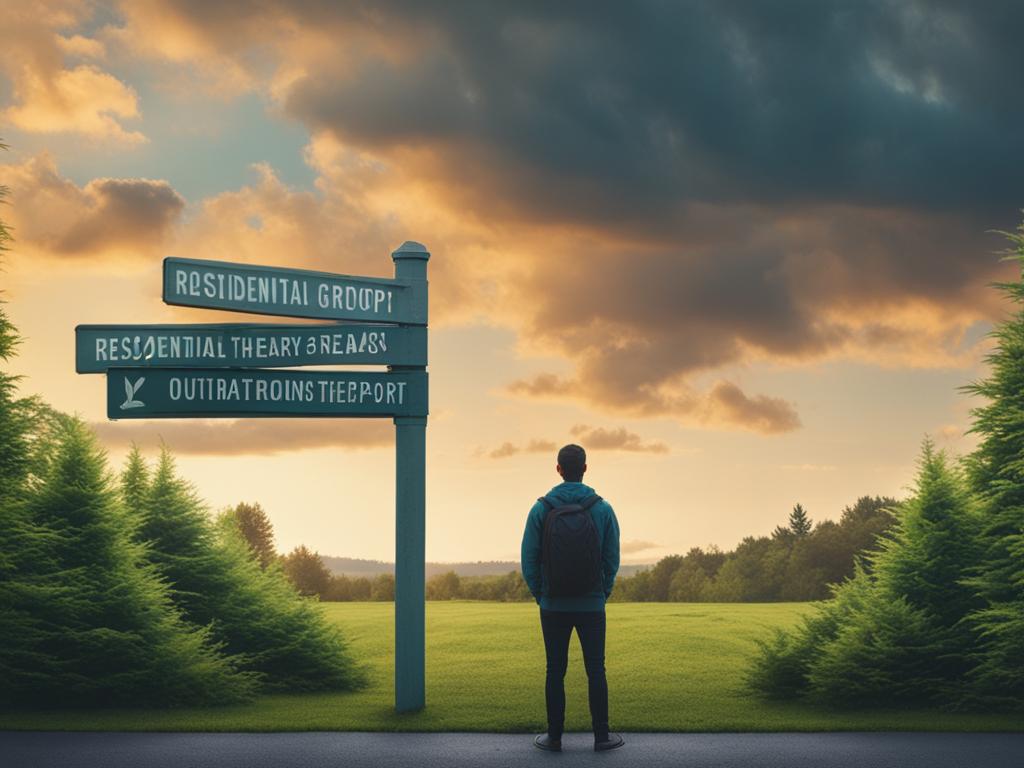We understand that choosing the right treatment for weed addiction recovery is an important decision. With many options available, it’s crucial to make an informed treatment selection that best fits the individual’s needs. As we explore various marijuana addiction help options, keep in mind that while marijuana dependence may be similar to other substance disorders, it is usually less severe. With proper research and considerations, finding suitable treatment for weed addiction can lead to long-lasting recovery and improved well-being.
Key Takeaways
- Marijuana dependence is similar to other substance dependence disorders but usually less severe.
- Adults seeking treatment often have a history of over 10 years of near-daily use and many unsuccessful quit attempts.
- Common symptoms of marijuana dependence include relationship issues, financial problems, guilt, dissatisfaction with productivity, sleep and memory problems, and low life satisfaction.
- Behavioral therapies, such as motivational enhancement therapy, cognitive-behavioral therapy, and contingency management, are effective treatments for marijuana addiction.
- Recognizing and treating co-occurring mental health disorders is crucial in the treatment of marijuana addiction.
- Various resources, including therapy and support groups, are available to help individuals on their journey towards sobriety.
Understanding Weed Addiction and Its Prevalence
Marijuana remains the most widely used illicit drug in the U.S. and Europe. Data suggests that marijuana dependence is a tangible condition resulting in social, psychological, and physical impairments. Despite some people questioning the concept of marijuana dependence, studies indicate that the condition is real and harmful. The prevalence of marijuana abuse and dependence disorders is on the rise among adults and adolescents in the U.S., which points toward significant public health concerns requiring systematic prevention and intervention efforts.
https://www.youtube.com/watch?v=Kc10GJFQYNE
The Rise of Marijuana Use Disorders
Cannabis dependence prevalence has been increasing over time, leading to a higher frequency in marijuana use disorders. The following table presents relevant statistics showcasing the rise in marijuana use and addiction:
| Year | Marijuana Use in U.S. Adults | Marijuana Use in U.S. Adolescents |
|---|---|---|
| 2002 | 4.1% | 8.2% |
| 2007 | 5.8% | 9.8% |
| 2013 | 7.5% | 11.6% |
| 2018 | 9.9% | 12.7% |
Recognizing the Signs of Marijuana Dependence
Signs of marijuana dependence in clinical populations appear similar to other substances, though perhaps less severe. Adults seeking treatment for abuse typically use the substance for over a decade and have attempted quitting multiple times, facing a variety of detrimental consequences. These include relationship and family issues, financial hardships, and a decline in personal satisfaction. Some common marijuana abuse symptoms are:
- Memory and concentration problems
- Difficulty quitting or controlling use
- Experiencing withdrawal symptoms when not using marijuana
- Continued use despite negative consequences
Adolescents and Young Adults: A Vulnerable Demographic
Adolescents under the age of 25 form a significant proportion of individuals entering treatment for marijuana use and present a distinctive profile of associated problems. They are at an elevated risk for adverse health and psychosocial outcomes, including sexually transmitted diseases, early school dropout, delinquency, and reduced educational and occupational aspirations. Young people, particularly minority youths, are susceptible to marijuana use disorders due to various factors, including acculturation, increased college attendance, and restricted access to legal psychoactive substances. Addressing marijuana use in adolescents and young adult weed addiction should be a priority for prevention and treatment programs to mitigate the long-term consequences of early substance use.
Exploring Available Treatments for Marijuana Addiction
When it comes to treating marijuana addiction, there are several cannabis abuse treatment options available to help individuals regain control of their lives. These treatments primarily make use of behavioral therapies, including motivational enhancement therapy, cognitive-behavioral therapy, and contingency management. Studies reveal the effectiveness of these approaches in reducing marijuana consumption and promoting abstinence.

“Treatment for marijuana addiction includes behavioral therapies like motivational enhancement therapy, cognitive-behavioral therapy, and contingency management.”
Outpatient therapy has been evaluated for adults and adolescents who abuse marijuana. The most favorable outcomes, particularly concerning abstinence rates, can be achieved by integrating motivational enhancement therapy (MET), cognitive-behavioral therapy (CBT), and contingency management (CM).
- Motivational enhancement therapy (MET) is a short-term therapy designed to strengthen motivation for change. It addresses patients’ ambivalence and employs a nonconfrontational approach.
- Cognitive-behavioral therapy (CBT) imparts skills to help patients avoid or manage situational triggers. It covers functional analysis of marijuana use, planning, drug refusal skills, and lifestyle management.
- Contingency management (CM) involves rewarding abstinence with incentives, such as vouchers or gift cards, to reinforce positive behavior.
Research indicates that combining these therapies can lead to greater success rates in treatment. The table below presents an overview of the main features of each therapy:
| Treatment | Aim | Key Components |
|---|---|---|
| Motivational Enhancement Therapy (MET) | Strengthen motivation for change | Nonconfrontational approach, addresses ambivalence |
| Cognitive-Behavioral Therapy (CBT) | Teach skills to avoid or manage triggers | Functional analysis, planning, drug refusal skills, lifestyle management |
| Contingency Management (CM) | Reward abstinence with incentives | Vouchers, gift cards or other tangible rewards |
In summary, the available treatments for marijuana addiction revolve around evidence-based behavioral therapies that have demonstrated effectiveness in reducing consumption and increasing abstinence. By considering each individual’s unique needs, a combination of MET, CBT, and CM can be tailored to optimize treatment outcomes and support lasting recovery.
Behavioral Therapies: Tailoring Treatment to the Individual
When it comes to treating marijuana addiction, a one-size-fits-all approach is often ineffective. Instead, tailoring treatment to an individual’s unique needs and circumstances is more likely to foster successful recovery. In this section, we explore three widely-used behavioral therapies: motivational enhancement therapy, cognitive behavioral therapy, and contingency management. These evidence-based approaches have demonstrated promise in treating adult marijuana dependence.
Motivational Enhancement and Cognitive Behavioral Therapies
Motivational enhancement therapy (MET) addresses ambivalence and strengthens motivation for change. Generally comprising a few sessions, this nonconfrontational approach focuses on engaging the individual’s intrinsic motivation and goal setting. Cognitive behavioral therapy (CBT), on the other hand, aims to equip individuals with the skills needed to avoid or manage problems related to marijuana use. Components of CBT may include:
- Functional analysis of marijuana use
- Goal planning and action steps
- Drug refusal skills
- Lifestyle management and coping strategies
Together, MET and CBT have demonstrated efficacy in reducing marijuana use and supporting abstinence.
The Role of Contingency Management in Recovery
Contingency management (CM), also known as rewards-based therapy, involves the use of incentives to encourage abstinence. Typically, vouchers or gift cards are awarded to individuals for meeting specific treatment goals or maintaining sobriety. CM has been shown to enhance the effectiveness of MET and CBT, resulting in longer periods of abstinence. A table illustrating the core features of each therapy:
| Therapy | Core Features |
|---|---|
| Motivational Enhancement Therapy (MET) | Nonconfrontational approach, addresses ambivalence, strengthens motivation for change, goal setting |
| Cognitive Behavioral Therapy (CBT) | Skill development, functional analysis of marijuana use, goal planning, drug refusal skills, lifestyle management |
| Contingency Management (CM) | Incentives (e.g., vouchers) for abstinence, enhances effectiveness of MET and CBT |
“Contingency management involves rewarding abstinence with incentives like vouchers or gift cards. Implementation of CM has been shown to enhance the effectiveness of MET- and CBT-based treatments and support longer abstinence periods.” – Source: Various trials evaluating CM in addressing adult marijuana dependence.
Each of these behavioral therapies offers unique and effective tools for addressing marijuana addiction. By tailoring treatment to the individual, professionals can provide personalized and comprehensive support, bolstering the chances of lasting recovery.
Addressing the Social Influences on Marijuana Use

When it comes to marijuana peer pressure and the social influence on drug use, external factors often play a significant role in an individual’s decision to engage in substance use. Recognizing these influences and learning how to navigate them effectively are crucial steps in preventing drug abuse and promoting healthy choices.
Navigating Peer Pressure and Social Contexts
Peer pressure and social contexts can contribute to the initiation and continuation of marijuana use, especially for adolescents and young adults. To resist these pressures and minimize drug use, it is essential to learn and practice suitable refusal skills techniques and assertiveness in drug refusal. Strategies to resist peer pressure include:
- Avoiding situations where drug use is prevalent;
- Providing a reason not to engage in the activity;
- Walking away from the situation when necessary;
- Joining a support group or seeking professional advice to aid in resisting social pressures.
Strategies for Assertiveness and Refusal Skills
Assertiveness plays a significant role in resisting peer pressure and standing firm on one’s decision not to use marijuana or other substances. It involves clear communication, respect for oneself and others, and standing up for your beliefs. Here are a few steps to enhance your assertiveness and refusal skills:
- State your answer firmly and confidently;
- Provide a reason for your decision;
- Show understanding towards the other person’s perspective;
- Practice the ‘broken record‘ technique, which involves repeating your refusal politely and consistently until the pressure subsides;
- Engage in role-playing or practice scenarios to build confidence in your refusal skills;
- Seek professional guidance or attend workshops to improve assertiveness and refusal skills.
Remember, personal choice plays a crucial role in reducing drug or alcohol use, and practicing refusal skills and assertiveness ensures that you can make the right decisions for your health and well-being.
Understanding the role of social influences on marijuana use is essential in combating drug abuse and cultivating healthier choices for individuals. Enhancing assertiveness and refusal skills can help resist peer pressure and promote personal autonomy in decision-making. Committing to change, seeking support, and learning effective strategies can significantly reduce the impact of marijuana peer pressure and other social influences on drug use.
Comparing Treatment Alternatives for Marijuana Dependency
Finding the most suitable treatment for marijuana dependency is essential for successful recovery. Various options are available, each tailored to address the unique needs and circumstances of the individual. When evaluating treatment alternatives, it is crucial to consider not just the drug use but also the whole person, taking into account co-occurring disorders, personal needs, and individual preferences.
Outpatient programs and intensive inpatient or residential treatments represent two primary categories of cannabis dependency treatment variations. Understanding these treatment alternatives allows individuals and their loved ones to make informed decisions.
“Effective treatment should address not only the drug use but the whole individual, considering their unique situation and any co-occurring disorders.”
Outpatient Programs
Outpatient programs provide flexible treatment options, ideal for individuals who need ongoing support while maintaining their daily responsibilities, such as work or school. These programs involve attending regular psychotherapy sessions, group therapy, and addiction education classes, focusing on learning essential skills for sustaining long-term recovery.
Intensive Inpatient or Residential Treatment
Intensive inpatient or residential treatments are a more immersive approach to recovery, where individuals reside at a treatment facility throughout the program duration. These programs offer comprehensive care, often including detoxification, group and individual therapy, aftercare planning, and access to various supportive resources. Intensive treatments best suit those with a severe dependency or co-occurring disorders, as they provide a supportive and structured environment to focus on recovery entirely.
Here’s a comparison of these two treatments:
| Treatment | Advantages | Disadvantages |
|---|---|---|
| Outpatient Programs |
|
|
| Intensive Inpatient or Residential Treatment |
|
|
Ultimately, the choice between these treatment alternatives for marijuana dependency depends on the individual’s unique needs and preferences. Assessing one’s personal situation, goals, and support system is crucial in selecting the most effective course of action for a successful, lasting recovery.
Marijuana and Mental Health: Dual Diagnosis Considerations
Addressing and treating co-occurring mental health conditions is crucial in the process of marijuana addiction treatment. Prolonged and heavy use of marijuana can lead to cognitive impairments and may increase the risk of developing mental health disorders. An effective treatment approach involves dealing with both marijuana use and any concurrent mental health issues, highlighting the complexity of dual diagnosis cases.

Identifying and Treating Co-occurring Disorders
When it comes to dual diagnosis treatment, the first step is identifying the presence of co-occurring disorders alongside marijuana addiction. Conditions such as depression, anxiety, and bipolar disorder are common in individuals struggling with substance abuse, and their presence can complicate the recovery process. Ensuring that both the addiction and the mental health disorder are effectively addressed is essential for a successful recovery.
“Effective treatment necessitates a comprehensive approach that deals with both marijuana use and any concurrent mental health issues, emphasizing the complexity of dual diagnosis cases.”
To provide the best possible care, clinicians should employ a holistic approach, considering each patient’s unique circumstances, needs, and preferences. This requires a thorough evaluation and accurate diagnosis of all co-occurring disorders to guide the development of a personalized treatment plan. Integrative treatments, such as cognitive-behavioral therapy, medication management, and support groups, have all been shown to offer significant benefit to those grappling with co-occurring disorders.
- Accurately diagnosing all co-occurring disorders
- Developing a personalized treatment plan that addresses both addiction and mental health issues
- Utilizing evidence-based therapies, such as cognitive-behavioral therapy (CBT)
- Establishing a strong support network for the individual
- Implementing medication management, if necessary
Expert care and compassionate support are paramount when assisting patients in their journey towards recovery. By addressing the specific needs of those living with dual diagnoses and implementing evidence-based therapies, clinicians can help their patients overcome the challenges of marijuana addiction and co-occurring mental health disorders, facilitating a healthier life and a brighter future.
Next Steps: Seeking Help and Embracing Sobriety
Acknowledging the need for help is the first step towards recovery from marijuana addiction. With the rise in marijuana use disorders, there has never been a more pressing time to seek support and embrace sobriety. Overcoming barriers such as stigma, fear, and a lack of motivation to change is crucial in the journey towards sobriety. There are numerous resources available that provide the necessary tools and environment to encourage a substance-free lifestyle and long-term recovery.
Once you have taken this essential first step, seeking out appropriate treatment and support is paramount. Engaging in therapy and joining support groups can help provide the structure and guidance required throughout the recovery process. Connecting with others who share similar experiences and goals can also play a significant role in maintaining sobriety and preventing relapse.
In conclusion, the key to success on this difficult, yet rewarding, journey is the recognition and acceptance of the need for assistance. By seeking addiction help, remaining proactive, and leveraging available resources, individuals can overcome marijuana addiction and achieve long-lasting recovery. The path to sobriety may not be easy, but the rewards are undoubtedly worth the challenge. Together, we can empower and inspire one another as we strive for a healthier and happier life, free from the grips of addiction.
FAQ
What are the symptoms and signs of marijuana dependence?
Symptoms of marijuana dependence include relationship issues, financial problems, guilt, dissatisfaction with productivity, sleep and memory problems, and low life satisfaction. Those struggling with weed addiction typically perceive themselves as unable to quit and experience a withdrawal syndrome upon cessation.
Are there specific treatment options for marijuana addiction?
Yes, treatment options for marijuana addiction include behavioral therapies such as motivational enhancement therapy (MET), cognitive-behavioral therapy (CBT), and contingency management (CM). These therapies have been shown to be effective in reducing consumption and promoting abstinence.
What is the role of contingency management in marijuana addiction treatment?
Contingency management involves rewarding abstinence with incentives such as vouchers or gift cards. Implementation of CM has been shown to enhance the effectiveness of MET- and CBT-based treatments and support longer abstinence periods in adult marijuana dependence.
How can individuals deal with social influences and peer pressure related to marijuana use?
Strategies to resist peer pressure and social influences include avoiding situations where drug use is prevalent, giving a reason not to engage, or walking away. Assertiveness is also key, involving clear communication and standing firm on one’s decision not to use substances.
What are the considerations for treating marijuana addiction alongside mental health disorders?
Recognizing and treating co-occurring mental health conditions is vital in the treatment of marijuana addiction. Effective treatment necessitates a comprehensive approach that deals with both marijuana use and any concurrent mental health issues, emphasizing the complexity of dual diagnosis cases.
How can individuals seek help and embrace sobriety for marijuana addiction?
Acknowledging the need for help is the first step towards recovery from marijuana addiction. Overcoming barriers such as stigma and lack of motivation to change is crucial. Various resources, including therapy and support groups, provide the necessary tools and environment to encourage a substance-free lifestyle and long-term recovery.
Source Links
- https://www.ncbi.nlm.nih.gov/pmc/articles/PMC2797098/
- https://americanaddictioncenters.org/marijuana-rehab
- https://positivechoices.org.au/students/making-choices
Author Profile

Latest entries
 BlogFebruary 20, 2024I Just Found the Ultimate Clog-Free Vape Cartridge! (Yes, They Exist!)
BlogFebruary 20, 2024I Just Found the Ultimate Clog-Free Vape Cartridge! (Yes, They Exist!) BlogJanuary 16, 2024In the Clouds with Creativity: A Blunt Encounter with Montreal’s Fluid Art Maestro
BlogJanuary 16, 2024In the Clouds with Creativity: A Blunt Encounter with Montreal’s Fluid Art Maestro BlogDecember 25, 2023Sativa: Enhancing Outdoor Adventures
BlogDecember 25, 2023Sativa: Enhancing Outdoor Adventures BlogDecember 25, 2023Enhancing Memory with Sativa
BlogDecember 25, 2023Enhancing Memory with Sativa





